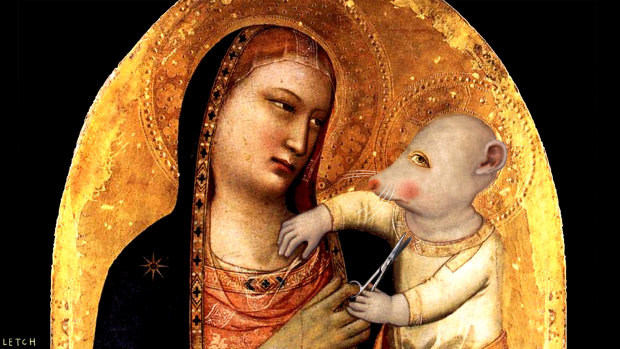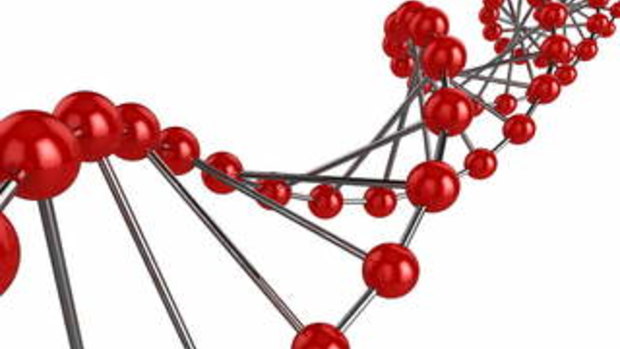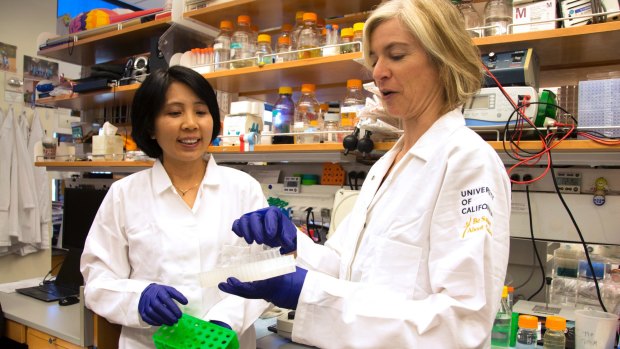This was published 6 years ago
Opinion
Science's new toy should scare us all
Elizabeth Farrelly
Columnist, author, architecture critic and essayist
Illustration: Simon Letch
This is a horror story. I hope it scares you, because just telling it scares me. It’s about public trust, emotive coercion, human futures and how all these sit at the mercy of tired, old neoliberal groupthink. It’s not about our cat Diesel, but that’s where it begins.
Diesel died. Burmese and much beloved, he was the kind of feline who liked to make eye contact, have a chat, touch your face gently until you did. At 16 he was still glossy and chipper, still capable of kitten-style vertical take-off. But when we moved house he became quite suddenly sick, developed diabetic ketoacidosis and died over a week of hospitalisation, despite dozens of scans, tests, drugs and procedures.
Apparently Burmese are genetically inclined to diabetes. Plus, you do have to die of something. But when I was a kid, animals died at home. You grieved, got over it. Now they die in hospital. Every day another thousand dollar scan or test is offered. Love kicks in. Who’s gonna say no? Don’t try it. Eventually you take out a second mortgage. But they still die.
This moral dilemma is an ironic result of miraculous modern medicine. And it’s going to get worse. Much worse.
In the not-distant future you’ll not only be buying genetically modified diabetes-free Burmese. You’ll be pressured to pay the extra few thousand for your unborn kid to have its Alzheimer's, breast cancer or cystic fibrosis gene removed, or better musculature added, before birth. Again, who will say no?
This ultra-precise gene-editing technology is virtually here, and improving every moment. This Wednesday, submissions close on a proposal from Dr Raj Bhula, Australia’s Gene Technology Regulator, to partially deregulate it, rendering gene-excision no longer classifiable as genetic modification.
No one disagrees that the existing Gene Technology Regulations 2001 need updating. The controversy is about the content.
The discussion so far has been dominated by stakeholders – and therefore both technical and supportive. It emphasises the gene editing’s benefits for agri-business, and how regulation must keep pace with scientific change to ensure that industry is not held back.
Even the ABC calls it “reform”, focusing on disease-resistant crops, hornless cattle and all-female chooks that will make agriculture cheaper – as though this automatically “feeds the planet”. That’s weird enough – although perhaps (you might argue) those species are already so synthetic that a little further intervention is trivial.
But Dr Bhula’s proposal is not just updating regulation. It’s deregulation, and at least one dramatic aspect of it is neither trivial nor self-evidently benign. This is the declassification of gene-editing techniques including the world-changing CRISPR, which will no longer count as genetic modification and therefore could occur without labelling – even in foods certified "non GMO” or organic.

The gene technology regulator is looking at deregulating the gene-editing technique CRISPR.
CRISPR stands for Clustered Regularly Interspaced Short Palindromic Repeats. It refers to a semi-repetitive pattern of genetic sequencing first found in DNA of certain E. coli bacteria that live in the human gut. That was the 1980s. People were intrigued because viruses are bacteria’s principal foe. Twenty years later these repeated patterns turned out to be part of a defence mechanism; gene cut-ins that effectively vaccinate the bacteria against viral attack.
More interesting still was how these patterns did that. They use what CRISPR co-discoverer, UCLA cell biologist Jennifer Doudna (who spoke in Melbourne last week) calls molecular scissors to slice through viral invaders, then insert part of the viral DNA into their own genomic sequence as an immune device.
Even by gene-editing standards, it’s an extraordinarily precise and effective tool. It’s also quick and cheap; moments instead of months, less than $100 instead of thousands. “The hairs on the back of my neck were standing up,” Doudna recalls, like a kid with a new toy. “I can program it to cut DNA wherever I want.”

CRISPR co-inventor Jennifer Doudna, right, and lab manager Kai Hong in Berkeley, California.Credit: Cailey Cotner
CRISPR lets you target particular genes or gene-sequences and excise them, or exchange them for something more desirable. Already it has been used experimentally to make mosquitoes incapable of carrying malaria, make cattle resistant to bovine TB, “cure” muscular dystrophy in mice and sickle-cell or HIV in human cells.
This seems good, right? Naturally it has cell biologists, agribusiness-types and venture capitalists enormously pumped. But all is not necessarily rosy. Perhaps the least of the issues is the planetary burden of all the lives so saved. Feed the starving millions, end epidemics, and millions more will come to demand even more from high-yield crops. But that’s barely the tip of the CRISPR-berg.
There’s designer babies, for a start. Already scientist-teams in China are using the technology on non-viable human embryos and at least one in the US has successfully used CRISPR technology to “correct” a pathogenic gene (known to cause a myocardial heart defect) in viable embryos.
So far, edited human embryos cannot legally be inserted into a uterus, anywhere, but no one really expects this ban to last.
The possibilities are limitless. UC biologist Beth Shapiro (who famously analysed the mitochondrial DNA of the dodo) and science-writer Carl Zimmer agree that CRISPR could, even now, turn a chihuahua into a great dane, or a chicken into a prehistoric raptor.
Going forward in time is just as easy, only scarier. You can’t, yet, invent a creature with CRISPR. But you can “improve”, making humans bigger, taller, stronger, smarter, healthier, more beautiful. You could make them all white, or black.
Scariest of all, you can encode it with a “gene drive” that lets designer-genes self-propagate into offspring, affecting all future generations, forever, everywhere.
Everyone except governments agrees this is terrifying. Even the scientists (Doudna and her colleagues) have called for a global pause in CRISPR’s human application, at least until we know it’s safe. Whatever that means.
But it can’t be regulated if it’s invisible. This is the question facing Australia right now. Should animals, plants and microbes produced using CRISPR (and similar technologies) be assessed for safety before being released into the environment and the food chain? Should they count as “genetically modified”? Should they, as foodstuffs, be labelled? There’s no good argument against, except profit.
Proponents point to CRISPR’s precision and affordability – but that’s why it’s scary. With sufficient wherewithal, a single person or corporation could change the human genome forever.
Have your say: Submissions to the OGTR review of Gene Technology regulations close on Wednesday, February 21.